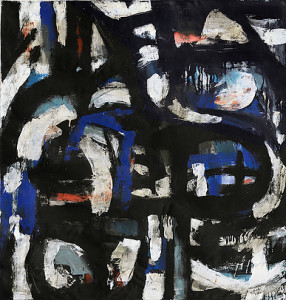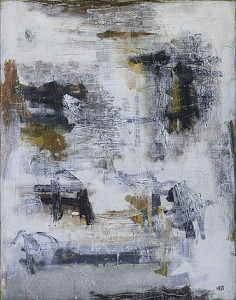
Guido Llinás, Cuba, 1923-2005
Black is the color. For Nina Simone, 2004.
About:
Enigmatic Signs: Guido Llinás
Edward J. Sullivan
The history of twentieth century Cuban art has been dominated by research and criticism of three phases: Modernism (Wifredo Lam, Amelia Pelaez and their contemporaries), the Generation of the 1980s and contemporary artistic projects. Those interested in developments in Cuban art are inevitably gratified by such critical attention. Throughout the twentieth and into the present century, Cuban art has played a central role in the international discourse of aesthetic evolution in the Western hemisphere. In speaking of the formation of modern Cuban art we must engage both with work produced by artists living on the island as well as that done abroad. Since the beginning of the Revolution and the start of several waves of large-scale emigration to places such as Miami, New York, Madrid and other sites, the Cuban diaspora inevitably has come to constitute an important element in the definition of Cuban creativity.
Painture, 1963.
One often thinks of Cuban art as referential. Concrete symbols or narrative signs recur throughout its development from the first vanguard generation that emerged in 1927 to the most recent work of internationally known contemporary figures. Issues of national identity or references to political events often lie at the heart of visual expression in Cuba. Yet abstraction has also played a significant yet much less well known role. In the early 1950s, the art world in Cuba, like other nations in the Americas and the Caribbean, felt a serious desire to evolve in directions similar to those paths taken by artists in Europe and North America. There was, on the part of some of the more experimental younger painters and sculptors, an anxiety to become more international or universal (to use the terminology often employed at the time). This meant looking beyond what were judged to be the confines of the national references in the art of the second generation of vanguardia painters to consider the consequences of the varieties of international abstraction, from the boldness of the New York School of Abstract Expressionists to the more subtle applications of non-objectivity of the Informalists in Paris, Madrid or Barcelona. In 1953 a group which became known as Los Once (the Eleven) held their first show in Havana. Althoug their number varied from year to year, the core group of artists (both painters and sculptors), including Antonio Vidal, Hugo Consuegra, Tomas Oliva and Guido Llinás, comprised one of the most vibrant forced of resistance to the traditional visual vocabulary of forms in Cuban art. The evolution of the group made for a significant chapter in mid-century art history in Havana. This development, however, was cut short by the Revolution and the ultimate departure of some of the artists for places abroad and the consequent dissolution of the group.
Untitled, 1970.
Guido Llinás left in 1953 for Paris, where he has lived ever since. The distance he felt from Havana (and his home province of Pinar del Rio) served to make his emotional and visual affinities for Cuba more acute. He continued to produce work in the abstract style he had developed by the beginning of the 1950s. The post-Cuba works often have generic titles (Signs, Black Painting, Red Painting). These paintings they blend the gestural qualities that relate him to Abstract Expressionism, with veiled references to Afro-Cuban ritual. Circles, arrows, the suggestion of an axe or a cross motif make their appearances in these pictures. None of these references specifically refer to a particular cult or form of worship. There is no instance of folkloric or primitivist self consciousness. German art historian Christoph Singler has written eloquently on Llinás affinities for Afro-Cuban mythology, yet all instances of this is redolent of subtlety and a lack of specificity. There is no nostalgia nor overt longing for a specific time or place.
Contrapunto, 2003.
Meyerplein, 1965.
The work of Guido Llinás is discreet in size. Each painting demonstrates an assuredness and an expertise in the craft and the art of painting. Llinás continues to evolve in a way that both testifies to his personal and aesthetic energy and to his assimilation and reinvention of the symbology of his Cuban heritage.
© 2015 Estate of Guido Llinás




